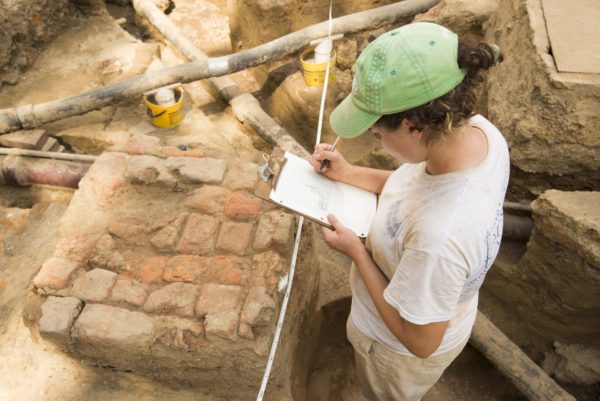
Archaeologist Brittany Higgs records a preserved patch of 18th-century brick paving along Duke of Gloucester Street at the Raleigh Tavern.
Archaeological research has a long history at Colonial Williamsburg, and this summer, visitors to the Historic Area had the unique opportunity to see it in action. For five months between Memorial Day and Halloween, Colonial Williamsburg’s archaeologists were busy systematically probing the ground in front of the Raleigh Tavern for evidence of a late 18th-century front porch that linked the iconic tavern to Duke of Gloucester Street.
The current Raleigh Tavern is a reconstruction built in the early years of the town’s restoration and sits atop the 18th-century foundations of the original, but its porch was not reconstructed as the available documentary and archaeological evidence was short on the details of the porch’s appearance and construction. In late spring the Foundation announced its intention to reconstruct the long-missing porch, and it was hoped that a reexamination of the site might yield useful new information toward informing its design.
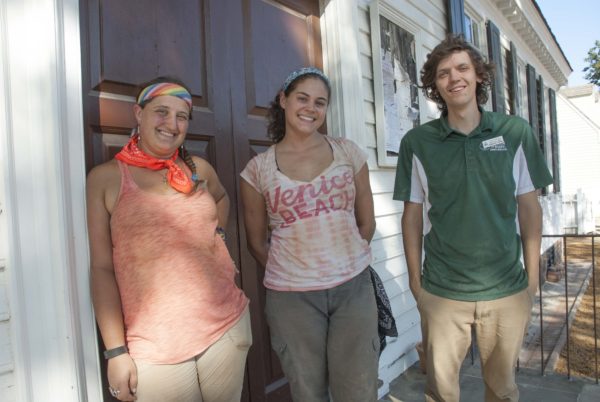
Raleigh Tavern archaeological field crew: Megan Victor, Brittany Higgs & Myles Sullivan.
Fieldwork in the summer months was hot and often uncomfortable, and the utility and planting disturbances to the intact archaeological layers and features were many, but the team’s persistence paid off when in the early fall they exposed a well-preserved series of 18th-century brick piers, almost certainly porch supports, stretching across the tavern’s front.
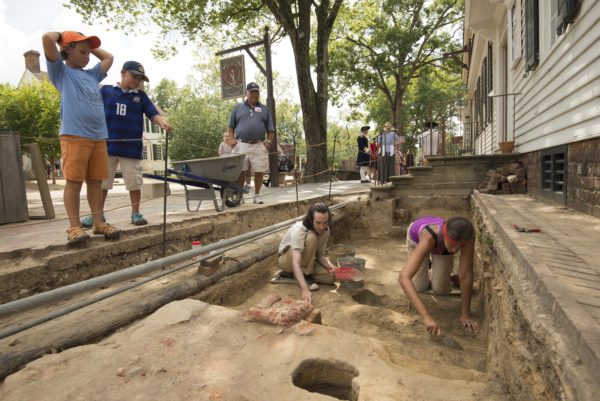
William & Mary Field School student Thomas Barto and Teaching Assistant Alexis Ohman excavate around an 18th-century porch pier in front of some interested site visitors.
Upon discovery, each pier was precisely measured, mapped, and photographed, and the soils that buried them were carefully sifted for fragments of pottery, glass, oyster shell, animal bone, and whatever else might turn up. The many thousands of artifacts collected from under and around the porch piers are now in the archaeological collections lab where they are being washed and catalogued to give us a better appreciation of 18th-century tavern life, and to better understand how the porch was used and modified over time.
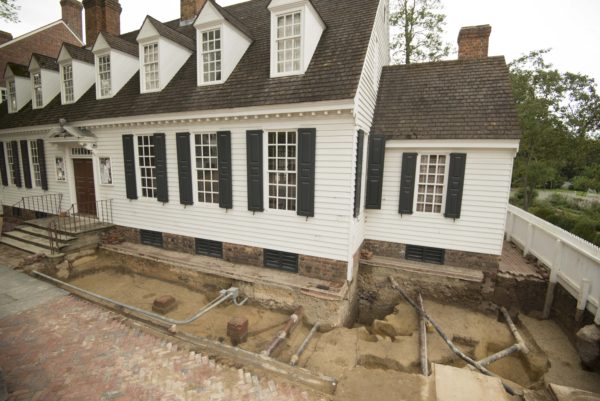
Archaeological excavations at the east end of the Raleigh Tavern with the 18th-century porch piers.
The first two brick piers uncovered were located to the east of the tavern’s front stoop. The two piers were the same as piers partially exposed in 1929 just prior to the tavern’s original reconstruction. At that time architect Thomas Waterman prepared a detailed plan map of the foundations found at the Raleigh Tavern site, but for whatever reason did not indicate the piers’ age. The omission of any comment led to the long-held assumption that the piers were not colonial. Evidence from the 2016 excavations, however, clearly established the piers were built in the middle decades of 18th century.
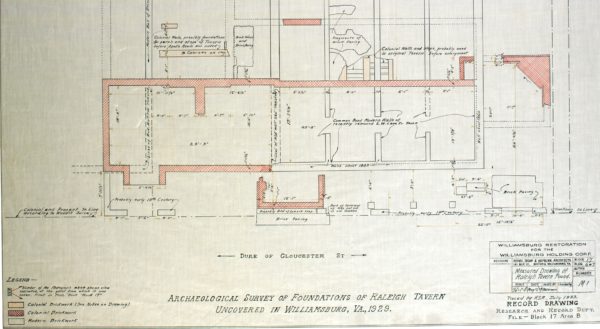
Detail of Thomas Waterman’s plan map of the 1929 excavations at the Raleigh Tavern site.
Additional brick piers of the same age and form were located at the tavern’s west end, between the front stoop and the cellar bulkhead. Their discovery was somewhat surprising, as Waterman’s 1929 excavation map shows no evidence of any piers, or any other features for that matter, in this area of the site. As it turns out, what had long been read as an absence of archaeological features on Waterman’s map was actually due to the lack of excavation!
With an eye toward starting construction in the spring, the next step is to compare our findings with other physical evidence such as still-standing 18th-century structures with porches surveyed by Colonial Williamsburg’s architectural historians.
The archaeological and architectural evidence, along with the previously mentioned documentary evidence, will then be integrated into a new digital model of the porch that can be used by the Foundation’s designers, architects, and engineers to develop detailed plans for a reconstruction of a porch on the Raleigh. The model and construction drawings will be completed in the months ahead, and we all look forward to the porch’s construction beginning soon.
Click here to support the Raleigh Tavern Porch Project and similar archaeological projects through the City Beautiful Fund!
GUEST BLOGGER: MARK KOSTRO
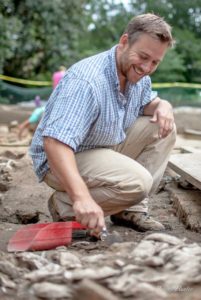 Mark Kostro is a staff archaeologist with the Colonial Williamsburg Foundation and the director of the annual Colonial Williamsburg/College of William & Mary Field School in historical archaeology. Mark was born in NYC and raised in suburban New Jersey, but now calls Williamsburg home with his wife and son. He earned a B.A. in History and Anthropology from Rutgers University (1996), and a M.A. in Anthropology from the College of William & Mary (2003) where he is currently a doctoral candidate in Anthropology. He is a Registered Professional Archaeologist with more than 20 years of experience specializing in Chesapeake and Caribbean historical archaeology. Over the last decade he has overseen several large-scale archaeological investigations in Williamsburg including: Richard Charlton’s 1765 Coffeehouse (2008-2011), the Brafferton Indian School at the College of William and Mary (2011-12), and most recently, the Bray African American School (2012-14).
Mark Kostro is a staff archaeologist with the Colonial Williamsburg Foundation and the director of the annual Colonial Williamsburg/College of William & Mary Field School in historical archaeology. Mark was born in NYC and raised in suburban New Jersey, but now calls Williamsburg home with his wife and son. He earned a B.A. in History and Anthropology from Rutgers University (1996), and a M.A. in Anthropology from the College of William & Mary (2003) where he is currently a doctoral candidate in Anthropology. He is a Registered Professional Archaeologist with more than 20 years of experience specializing in Chesapeake and Caribbean historical archaeology. Over the last decade he has overseen several large-scale archaeological investigations in Williamsburg including: Richard Charlton’s 1765 Coffeehouse (2008-2011), the Brafferton Indian School at the College of William and Mary (2011-12), and most recently, the Bray African American School (2012-14).

Leave a Reply